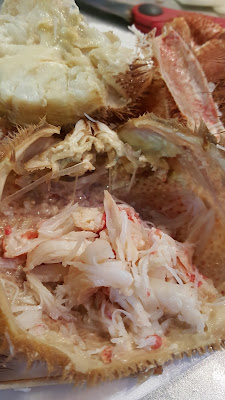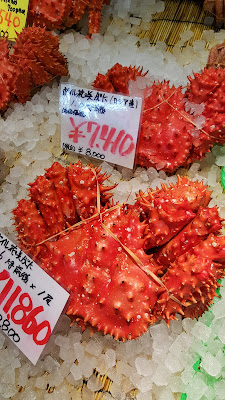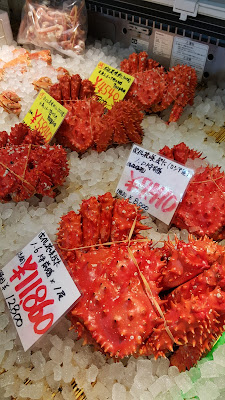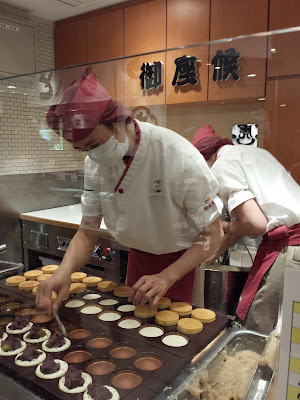A Taste of Northern Japan
Hokkaido is the second largest island at the northernmost part of the Japanese archipelago that is well-known for their fresh seafood, onsens (hot springs) and breathtaking scenery.
I joined Tashi in Sapporo in the first week of February, that also coincided with the Sapporo Snow Festival. It was an impromptu trip to Hokkaido, having only one week at hand -- the thought of indulging in the food culture and onsens in Jozankei and Otaru was enough to whet my appetite.
I joined Tashi in Sapporo in the first week of February, that also coincided with the Sapporo Snow Festival. It was an impromptu trip to Hokkaido, having only one week at hand -- the thought of indulging in the food culture and onsens in Jozankei and Otaru was enough to whet my appetite.
Otaru -- bounty of the seas...the freshest of sashimi and the seasonal cod fish sperm sacs (bottom right), truly a feast for the eyes.
Otaru
A small harbour city located in northwest Sapporo is about an hour journey by train. The Otaru Snow Light Path Festival (Otaru Yuki Akiri no Michi) coincides with the Sapporo Snow Festival, typically runs for ten days in each February, turns Otaru into one enchanting townscape of snow lamps and lights.
We stayed two nights in Otaru walking the streets and tasting the local flavours!
Paper Hotpot or commonly known as "Kami Nabe" -- I opted for the seasonal seafood selection. (JPY1500/USD14)
The Cod or "Tara" in Japanese means "Snow Fish" -- this is mostly enjoyed raw or cooked.
Shirako -- the sperm sacs of the male cod fish is an extremely popular delicacy in Japan. It is either served raw or lightly boiled. It is equally popular served as sushi in gunkan shape. The chef-owner of this restaurant prepares this seasonal delicacy in five different styles.
I have tasted the shirako sashimi several times. This was my first at savouring the cod fish sperm sacs lightly boiled, accompanied with a variety of seafood, leek and mushroom -- the texture is non-creamy, light and very clean.
This cozy traditional Japanese restaurant is located within walking distance from the Otaru canal. We walked into this restaurant by chance and since we were early, we got the best seats at the counter.
Another variety of the seafood Kami Nabe (JPY1800/USD17).
This cozy traditional Japanese restaurant is located within walking distance from the Otaru canal. We walked into this restaurant by chance and since we were early, we got the best seats at the counter.
The owner-chef, Yoshio Kenmoku, is one cheerful guy who gave us a sticker with his image on it and a thumbs up (Ichiban) that he serves the best sashimi in town. Absolutely, the best shirako!
eiroku is located at 1 Chome-2-14 Ironai,Otaru. (website: www.otaru-eiroku.com)
We took a leisurely, long walk from our hotel (about five minutes from the Otaru station), headed down the canal. We stopped to enjoy the picturesque snow covered old warehouses and the quaint, fishing vessels anchored by the canal.
We have not planned to wake up at wee hours of the morning on a cold February day to catch the bustling scene in this local neighbourhood market. It is smaller than Kushiro Washo Market in Sapporo, but better value for fresh catch.
A friendly, fish vendor at this stall was watching us from across our table digging into our crabs, with our teeth and fingers. She then came over with her pair of scissors to help break up the crab!
My love for Hokkaido kani has always been to enjoy them during the harsh winter season, caught off the coast of Hokkaido, the Okhotsk Sea -- large quantities of phytoplankton contained in the sea ice are released, when the ice melts, creating a major feeding ground for crabs. This is when the crabs have been fattened on these nutrients, making them the most flavourful -- the harsh winter condition is what helps the crab meat to become plump, soft yet tightly packed, at the same time.
Kegani -- the popular horsehair crab is my favourite variety. The medium-sized crab is at JPY2000 (USD18).
All fresh crabs are best enjoyed whole, a heavenly meal by itself.
The Horsehair (Kegani) is amazingly flavourful, naturally sweet yet has that stronger savoury taste of the ocean, and the shell so thin that one can see through it. Insanely good when digging in with all fingers, teeth and a little help with a pair of scissors, borrowed from the friendly fish vendor.
Snow crab (zuwagani) and Red king crabs (tarabagani)
Red king crab (zuwagani) -- the smallest-sized of cooked on the spot. (JPY7500/USD69).
After a hearty crab meal, we stopped at this dried seafood stall. This vendor spoke minimal English, but enough to get us to buy a bag full of them. We tasted almost all of the different variety!
I bought a bag full of several packets of the naturally dried salmon stripes (with skin), black ink squid (only the wings part), cod, whole herring, more whole squids of different species, and the irresistible dried kelps! All at JPY7500 (USD69)
At this canal warehouse, we browsed through the souvenir stalls around the centre court, and eventually ended up inside this packed eatery for a warm bowl of handmade springy, tasty noodles. (JPY800)
While happily slurping away at my noodles (the Japanese noodle culture), I could not take my eyes off this sign that stares back at me -- they also make their very own Hokkaido dairy milk pudding!
Sweet, smooth, tasty homemade Hokkaido milk pudding (JPY250/USD4.60).
Hokkaido soft ice-creams
Hokkaido produces the freshest and finest quality of dairy products such as butter, soft ice-cream, yoghurt, cheese, as well as a wide range of food and beverages using Hokkaido milk.
Hokkaido produces the freshest and finest quality of dairy products such as butter, soft ice-cream, yoghurt, cheese, as well as a wide range of food and beverages using Hokkaido milk.
The 7-layered soft ice-cream is a must-try! This eatery serves a good variety of other flavours as well as other local eats. I went for a second round to try the rich, creamy soft serve with raw chocolate chips with a sprinkle of raw grounded cacao. Simply heavenly!
The 7-flavoured ice-cream at JPY770 costs slightly more here. The all natural rich, creamy, full body soft serve with raw cocao chips and raw grounded cocao topping costs JPY420, but the quality speaks for itself!
While indulging in my ice-cream world, looking out of the window, on a cold, snowy evening, and tempted into having a third round, I then noticed there was absolute silence with just the two of us left -- the crowd has gone because it was almost closing time. They let us stay on after closing hours, until I finished my multi-flavoured soft serve!
Otaru sake and wine
Hokkaido is not only favours for their freshly-brewed beer, but also renown for their sake and wine, and whisky. Among the four major beer breweries, Sapporo brewery is also famous for its beer halls and beer gardens -- a paradise for beer lovers.
We wanted to have a taste of the unique sake and wine culture in Otaru, and found our way to the Tanaka Shuzo Shop after a late morning trip to Rinyu Morning Market.
Located off the main thoroughfare, this shop has an impressive selection of sake and wine. There is a separate room, filled with an array of award winning sake and their popular range of wine; using the natural resources from their land -- the finest quality rice and pristine water.
Freshly brewed unprocessed sake -- the award winning sake for the year 2015, that I tasted and bought. This particular sake is only available in their shop, and not in their brewery.(JPY2265)We wanted to have a taste of the unique sake and wine culture in Otaru, and found our way to the Tanaka Shuzo Shop after a late morning trip to Rinyu Morning Market.
Located off the main thoroughfare, this shop has an impressive selection of sake and wine. There is a separate room, filled with an array of award winning sake and their popular range of wine; using the natural resources from their land -- the finest quality rice and pristine water.
We also tasted the entire range of their fruit wine besides the sake. Their Hokkaido wine selection -- the "Otaru beauty series" is created with the ladies in mind. The fruits are harvested from their local fruit farms in Yoichi using all natural fruits -- the blueberry, plum, peach, prune and aronia variety, with no added sugar, and each uniquely blended to give it the amazing light-bodied, aromatic flavours. (JPY1260).
According to the shop manager, the best time to enjoy the berries is to visit in September or October in Yoichi. The local folks usually make a day trip to the farms to enjoy the seasonal fruits. Bus fare is at JPY500 per trip from Otaru City. A good option is to do self-drive if there are four of you and in good weather condition.
I hope to make a trip back to visit the Kitanohomare Shuzenken Brewery that we missed on this trip because it was closed, and to Yoichi, the Nikka whisky distillery to have a taste of their malt whisky, known to be the best in Japan, and also world renown.
Jozankei
The valley in the hot spring region is just about under an hour drive, within close proximity to Sapporo. This is a popular getaway destination for the locals and foreign tourists alike, particularly during the Sapporo Snow Festival season.
This is one place to chill out, indulge in the indoor and outdoor onsens and the warming winter food culture.
This is one place to chill out, indulge in the indoor and outdoor onsens and the warming winter food culture.
We have had the good fortune to be pampered with a Japanese Kaiseki -- a traditional dinner on this occasion. The tatami style dinning area exudes a warm ambiance. A soft spoken staff greeted us at the entrance as we took off our slippers before entering.
A Kaiseki experience -- the almost Zen-like art of this traditional multi-course dinner was absolutely one of pure delight. The colours of each individual dish presented was meticulously thought out using the most natural ingredients, prepared, cooked and displayed in each bowl and plate.
Seared tuna, sliced and accompanied with freshly cut mixed ginger, scallion and interesting ingredients that did not require to go with soya sauce at all. In fact, no wasabi was served either -- there was no need to do so when only the natural and freshest of ingredients were used, so artistically and skillfully prepared by the chef and his team that I could taste the purity, the essence of their land.
Soup with seafood ball and a sprig of green -- the unique seafood ball tasted naturally flavourful.
Kaiseki breakfast -- an good selection of fresh squid, grilled salmon and delectable fresh salads, natto and fruits.
Buffet dinner at The Food Factory Grandeur -- the buffet dinner in the buffet restaurant, a food factory concept, cooking using Hokkaido ingredients, in a satellite kitchen, prepared right before your eyes has a wide variety of traditional range as well as the popular Hokkaido food selection.
Stingray with fresh peas
A hearty buffet breakfast at The Food Factory Grandeur
Kaiseki breakfast
Kaiseki breakfast -- squid sashimi (Ika no sashimi) and natto.
Kaiseki dinner
The Bread Shop
Tashi wanted to try out this unique bakery shop that is out-and-out of the tourist and travellers zone, nestled in the forest. We eventually found it after asking the locals during our long walk in the thick snow to discover a cozy, family-run bakery.
Vergine Baccano -- the bakery shop with a stone chimney.
They also serve a variety of continental food in their cozy cafe. We bought some bread to takeaway.
We stayed in to have a second round of soft ice-creams that their boys also enjoyed having at the same time upon each of our order.
According to the baker and owner, he was absolutely enchanted with French bread, when learning French cuisine in France that he decided to open his own bakery upon his return.
He creates artisan fresh bread in his stone oven using Hokkaido wheat. They also sell Hokkaido lavender honey, harvested last July from the famous lavender fields -- the small 300gm bottle at JPY1500 (crystallized honey). There was no sampling available, but I bought one since lavender has been cultivated in Hokkaido for over 50 years. I found it to be slightly too sweet for my palate.
The soft ice-creams of the various flavours became a part of our daily diet that we enjoyed having, usually with a second round and sometimes, a third serve for me.He creates artisan fresh bread in his stone oven using Hokkaido wheat. They also sell Hokkaido lavender honey, harvested last July from the famous lavender fields -- the small 300gm bottle at JPY1500 (crystallized honey). There was no sampling available, but I bought one since lavender has been cultivated in Hokkaido for over 50 years. I found it to be slightly too sweet for my palate.
During winter, it helps to give them a call before visiting them at Minami-ku Jozankei Onsennishi 2-chome45. (tel: +81 11 5985588)
A sancha tea break before indulging in the indoor and outdoor hot springs (onsens), and before dinner and breakfast each day.
We enjoyed the authentic Japanese accommodation experience throughout our stay -- the spacious tatami family sized room (can stay up to 4 adults) for the two of us with fantastic views of the river, the red bridge and the snowy mountains.
During our stay, we put on the yukata provided in our tatami room -- a traditional garment, rather similar in style to kimono, but lighter, casual, and made of cotton. The Yukata is often used as loungewear and bathrobe, that conveniently allow us to roam about freely during our stay, to the onsen and dining area.
The first two hotels were popular with the locals -- the staff spoke only Japanese. The third hotel had a good mix of largely locals and foreign tourists -- the front desk staff spoke Mandarin besides English. We have had the good fortune to experience the best of the local onsens and food culture.
We walked around the town in the snow and found the bakery shop. There were snow sports available nearby without the crowd. A fantastic winter destination not to be missed.
Most hotels arrange for round trip complimentary transfers from JR Sapporo Station or from Chitose Airport, and do inform the hotel for advance booking of seats upon room confirmation.
We walked around the town in the snow and found the bakery shop. There were snow sports available nearby without the crowd. A fantastic winter destination not to be missed.
Most hotels arrange for round trip complimentary transfers from JR Sapporo Station or from Chitose Airport, and do inform the hotel for advance booking of seats upon room confirmation.
Sapporo Snow Festival
The Sapporo Snow Festival is an annual major winter event that falls in the second week of February for seven days and attracts over two million visitors. It is the largest snow festival in Japan and is world renown.
Since I have had only two nights at hand, we visited the local market for seafood and the local shops for snacks and naturally, more soft ice-creams!
Odori Park -- the many food booths that lined the park during the snow festival week. There were regional food to sample as well as international fares. We stopped at this local seafood booth to try out their whelk and squid teriyaki (JPY400/stick).
Fish Market walking distance to the Soan station -- this Fish Market is off the main thoroughfare, the place I prefer to be, with less tourists and better value to enjoy Hokkaido fresh seafood and sample the variety of dried seafood.
Uni (sea urchin) -- the freshest is to savoured them neat, on its own, with a taste of the ocean!(JPY2500)
Live abalone (awabi)
The interesting eight angled dragon fish.
Sapporo Station and JR Tower
This is a sprawling network of shops, department stores, eateries and offices, interconnecting the five areas -- Apia, Daimaru, Esta, Paseo and Stellar Place all of which connect through the Sapporo underground subway. This is one convenient area to chill out during unforgiving weather conditions.
The pricey white strawberries are available in the Daimaru food hall -- an intriguing sight. They were first grown around 2006; the flesh completely white, but they are not albino strawberries. They are probably the most expensive strawberries in the world!
Taiyaki -- we went on a tasting spree since Tashi is a bigger fan than I. A delicious, traditional Japanese Dorayaki (Doraemon's favourite snacks!), they come in round shaped and the fish shaped (taiyaki), filled with adzuki beans, and best enjoy with a cuppa or coffee or even ice-creams!
Dorayaki -- the pancake dough and adzuki beans varies in texture at the different stalls in Hokkaido. The degree of the sweet bean paste differs though I prefer the coarse grounded kind as they tend to be less sweet with a firmer bean texture.
We chanced upon this traditional taiyaki stall, managed by a couple, when on our way to Susukino district. After tasted one, I went back for more of them!
This gelato ice-cream stall is a must-stop for a triple scoop when passing through, at the JR Sapporo Station. I started enjoying them on my first day, while waiting to meet up with Tashi to arrive.
The week before Valentine's Day, they dangled a rich chocolaty experience that I could not resist!
The rich, creamy soft-creams that I could not stay away from at the Kinotoya Bake!
Kinotoya Bake is famous for their freshly baked cheese tarts, located in JR Sapporo Station
The Ice Festival in Susukino District featuring the popular Sapporo lager beer needs no introduction -- their label displaying the Pioneers' symbol, the North Star dates back over a century, has evolved over the years since 1877. For a slice of the history of beer in Japan, visit the Sapporo Beer Museum.
The last trip here during the summer felt as if it was only yesterday -- the soft-creams and the Sapporo Beer just came alive, but with so much more happening now during the winter season, especially for the live seafood, the sake and wine tasting, yummy soft ice-creams, and the endless varieties of snacks and dried seafood that already had me thinking of making the next trip back before this trip even ended!
The last trip here during the summer felt as if it was only yesterday -- the soft-creams and the Sapporo Beer just came alive, but with so much more happening now during the winter season, especially for the live seafood, the sake and wine tasting, yummy soft ice-creams, and the endless varieties of snacks and dried seafood that already had me thinking of making the next trip back before this trip even ended!
(Travelled, February 2016)
























































































